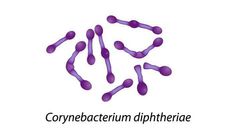![]()
![]()
![]()
Use LEFT and RIGHT arrow keys to navigate between flashcards;
Use UP and DOWN arrow keys to flip the card;
H to show hint;
A reads text to speech;
30 Cards in this Set
- Front
- Back
|
Corynebacteria can be broadly divided into 2 types |
● Lipophilic corynebacteria ● Non-lipophilic corynebacteria |
|
|
Corynebacterium species can be opportunistic. T/F |
True. |
|
|
What are lipophilic corynebacteria |
They are corynebacteria that are fastidious and slow growing in media (but addition of lipids to media enhances their growth) |
|
|
Disease cause by C. diphtheriae is called |
Diphtheria |
|
|
Corynebacteria appearance on gram staining |

● Gram positive ● Appear as curved rods with unparalleled sides and slightly wider ends (Club shape) ● V or L formation |
|
|
Diphtheria toxin is produced by what strain of C. diphtheriae |
Produced by those infected with "lysogenic Beta phage that carries TOX gene". Incorporation of the gene into bacteria genome make it a toxic strain. |
|
|
Molecular weight of diphtheria toxic |
62,000 Da (62kD) |
|
|
Is diphtheria toxin very potent? |
Yes, it is. Very potent and lethal in amounts of 130ng/kg of body weight |
|
|
How does diphtheria toxin act |
It inhibits protein synthesis in eukaryotic cells of body by ribosylating and inactivating Elongation factor 2 (EF2). This leads to cell death |
|
|
Is diphtheria toxin produced in toxic or non-toxic form |
It is first produced in its non-toxic form. Exposure to trypsin activates it by cleaving it into 2 subunits A and B, both of which are needed for its toxic effects. |
|
|
The initial non-toxic form of diphtheria toxin is made toxic by action of |
Trypsin |
|
|
Discuss the pathogenesis of diphtheria toxin |
● Diphtheria toxin initially produced in non-toxic form is cleaved by trypsin to 2 subunits A and B, making it toxic ● A is Active subunit while B is Binding subunit ● The B subunit binds to membrane receptors of cells creating channel for A subunit to enter the cell ● A subunit acts on NAD and splits it into Nicotinamide and Adenosine Diphosphoribose (ADPR) ● ADPR ribosylates Elongation factor 2 (EF2) inactivating it, hence preventing polypeptide elongation and protein formation. ● This causes cell death and exudate accumulation that form PSEUDOMEMBRANE in sites of infection (tonsils, Larynx, pharynx) |
|
|
Production of diphtheria exotoxin invitro is dependent on certain factors. Mention them |
● Alkaline pH (7-8) ● Availability of iron ● Oxygen |
|
|
The most important factor needed for production of diphtheria exotoxin invitro is |
Availability of Iron (very key) |
|
|
C. diphtheriae causes 2 types of diseases (diphtheria) in humans, mention them. |
● Respiratory diphtheria ● Cutaneous diphtheria |
|
|
The type of vaccine against diphtheria is a |
Toxoid vaccine |
|
|
The ONLY natural hosts of C. diphtheriae are |
Humans |
|
|
C. diphtheriae is spread by |
● Respiratory droplets (as seen in sketchy) ● Hand to mouth contact |
|
|
The common sites of infection of C. diphtheriae are |
● Pharynx ● Tonsils |
|
|
Does diphtheria toxin affect the heart? |
Yes, it causes cardiotoxic effects like arrhythmias, heart block, myocarditis. |
|
|
Cutaneous diphtheria is also known as ? Why is it called that |
● Desert sores ● Because it causes non healing ulcers with dirty grey appearance (like the appearance of pseudomembrane) |
|
|
C. diphtheriae is highly Pleomorphic. T/F |
True (despite being described as club shaped, they are pleomorphic) |
|
|
The metachromatic granules of C. diphtheriae are known as |
Babès-Ernst granules (composed of polymerized polyphosphates) |
|
|
Based on aerobic and anaerobic classification, what type of organism is C. diphtheriae |
Facultative anaerobe (though it grows best at aerobic state like most facultative anaerobes) |
|
|
Growth media of C. diphtheriae are? What optimum temperature does it grow |
● Growth media : Loeffler's media, Pai media, Cystine-Tellurite blood media ● Optimum temperature : 37°C |
|
|
Test to differentiate toxic and non-toxic strain of C. diphtheriae is called |
Elek test |
|
|
Describe C. diphtheriae based on ● Catalase test ● Nitrate test ● Lactose fermenter ● Motility |
● Catalase positive ● Converts nitrate to nitrite ● Lactose fermenter (pink on MacConkey agar) ● Non-motile It has the same general features as STAPH and STREP. |
|
|
Anthrax is a disease commonly found in |
Cattle, goat, sheep |
|
|
Anthrax is a also known as |
Wool sorter's disease or Rag picker's disease |
|
|
The 3 routes of exposure to B. anthracis are |
● Cutaneous ● Inhalational ● Ingestion |

